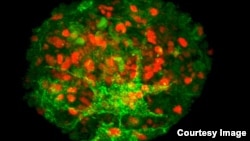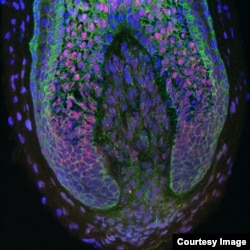Researchers at the Columbia University Medical Center may have come with something that many have been in search of for years, the ability to actually grow new hair on a balding head.
The researchers, writing in a study that was published online Monday by the Proceedings of the National Academy of Sciences (PNAS), say they have come up with a method that can actually generate new hair growth, not just redistribute hair from one particular part of the head to another.
Most people normally shed between 50 and 100 strands of hair each day. Losing that much hair, believe it or not, shouldn’t cause noticeable thinning of scalp hair says the Mayo Clinic. But for many, especially as they get older, their hair gradually thins out, some to the point where the hair loss or alopecia can affect a person’s overall appearance.
Since, to many, a full healthy head of hair symbolizes youth and vitality, a balding head could represent the opposite, getting old and not being as vibrant.
As a result, the hair restoration industry has become a $1.88 billion a year business.
Hair loss in women can prove to be a much more serious problem than in men, since the psychological effects and the impact to self-esteem due to hair loss can be increased.
Many of today’s modern restoration techniques may not be as effective since women tend to have insufficient donor hair.
"About 90 percent of women with hair loss are not strong candidates for hair transplantation surgery because of insufficient donor hair," said co-study leader Angela M. Christiano, PhD, a professor of dermatology and professor of genetics & development. "This method offers the possibility of inducing large numbers of hair follicles or rejuvenating existing hair follicles, starting with cells grown from just a few hundred donor hairs. It could make hair transplantation available to individuals with a limited number of follicles, including those with female-pattern hair loss, scarring alopecia, and hair loss due to burns."
Patients suffering from such hair loss, according to Christiano, gain very little benefit from the already existing hair-loss treatments and medications. While the treatments may slow down the rate of hair loss, they usually do not stimulate robust new hair growth.
The researchers said that dermal papilla cells – protrusions from inner skin tissue – can produce hair follicles. They also said the idea of using the cells to clone hair follicles has been around for the last 40 or so years.
In past experiments, the researchers said that they had some problems in actually producing human hair follicles. They found that once they put dermal papilla cells into a conventional, two-dimensional tissue culture instead of producing hair follicles as they had hoped, the cells simply reverted into basic skin cells that weren’t able to produce hair follicles.
“So we were faced with a Catch-22: how to expand a sufficiently large number of cells for hair regeneration while retaining their inductive properties,” said Colin Jahoda, from Durham University, England, and co-director of North East England Stem Cell Institute.
To get beyond this paradox the researchers studied rodent hair. With a method developed by Jahoda, scientists were able gather papillae cells from rodents, grow hair and successfully transplant the cells back into rodent skin.
The researchers said that they suspected that the chief reason why rodent hair can be so easily transplanted is that, unlike human papillae, their dermal papillae must have an ability to create a special environment outside of the cells, which would allow the papillae to reprogram the skin of the recipient to grow new follicles.
"This suggested that if we cultured human papillae in such a way as to encourage them to aggregate the way rodent cells do spontaneously, it could create the conditions needed to induce hair growth in human skin," said the study’s first author Claire A. Higgins, PhD, associate research scientist.
In order to see if their theory could be proven, the scientists gathered dermal papillae from seven human donors and cloned the cells in a tissue culture, adding no additional growth factors into the mix.
A few days later, they transplanted the cultured papillae between the dermis and epidermis of human skin and then grafted the skin onto the backs of mice.
The researchers found that in five out of seven tests performed not only did the transplants produce new hair growth, but the hair itself also lasted for at least six weeks.
Using a DNA analysis, the researchers confirmed that the new hair follicles that grew on the mice’s backs were indeed human and that they genetically matched the donors.
"This approach has the potential to transform the medical treatment of hair loss," said Christiano. "Current hair-loss medications tend to slow the loss of hair follicles or potentially stimulate the growth of existing hairs, but they do not create new hair follicles. Neither do conventional hair transplants, which relocate a set number of hairs from the back of the scalp to the front. Our method, in contrast, has the potential to actually grow new follicles using a patient's own cells. This could greatly expand the utility of hair restoration surgery to women and to younger patients—now it is largely restricted to the treatment of male-pattern baldness in patients with stable disease."
The scientists did point out that more research and study will need to be done before they can actually test the method on humans.
The research team said they are optimistic that clinical trials could begin in the near future.
"We also think that this study is an important step toward the goal of creating a replacement skin that contains hair follicles for use with, for example, burn patients," said Jahoda.
The researchers, writing in a study that was published online Monday by the Proceedings of the National Academy of Sciences (PNAS), say they have come up with a method that can actually generate new hair growth, not just redistribute hair from one particular part of the head to another.
Most people normally shed between 50 and 100 strands of hair each day. Losing that much hair, believe it or not, shouldn’t cause noticeable thinning of scalp hair says the Mayo Clinic. But for many, especially as they get older, their hair gradually thins out, some to the point where the hair loss or alopecia can affect a person’s overall appearance.
Since, to many, a full healthy head of hair symbolizes youth and vitality, a balding head could represent the opposite, getting old and not being as vibrant.
As a result, the hair restoration industry has become a $1.88 billion a year business.
Hair loss in women can prove to be a much more serious problem than in men, since the psychological effects and the impact to self-esteem due to hair loss can be increased.
Many of today’s modern restoration techniques may not be as effective since women tend to have insufficient donor hair.
"About 90 percent of women with hair loss are not strong candidates for hair transplantation surgery because of insufficient donor hair," said co-study leader Angela M. Christiano, PhD, a professor of dermatology and professor of genetics & development. "This method offers the possibility of inducing large numbers of hair follicles or rejuvenating existing hair follicles, starting with cells grown from just a few hundred donor hairs. It could make hair transplantation available to individuals with a limited number of follicles, including those with female-pattern hair loss, scarring alopecia, and hair loss due to burns."
Patients suffering from such hair loss, according to Christiano, gain very little benefit from the already existing hair-loss treatments and medications. While the treatments may slow down the rate of hair loss, they usually do not stimulate robust new hair growth.
The researchers said that dermal papilla cells – protrusions from inner skin tissue – can produce hair follicles. They also said the idea of using the cells to clone hair follicles has been around for the last 40 or so years.
In past experiments, the researchers said that they had some problems in actually producing human hair follicles. They found that once they put dermal papilla cells into a conventional, two-dimensional tissue culture instead of producing hair follicles as they had hoped, the cells simply reverted into basic skin cells that weren’t able to produce hair follicles.
“So we were faced with a Catch-22: how to expand a sufficiently large number of cells for hair regeneration while retaining their inductive properties,” said Colin Jahoda, from Durham University, England, and co-director of North East England Stem Cell Institute.
To get beyond this paradox the researchers studied rodent hair. With a method developed by Jahoda, scientists were able gather papillae cells from rodents, grow hair and successfully transplant the cells back into rodent skin.
The researchers said that they suspected that the chief reason why rodent hair can be so easily transplanted is that, unlike human papillae, their dermal papillae must have an ability to create a special environment outside of the cells, which would allow the papillae to reprogram the skin of the recipient to grow new follicles.
"This suggested that if we cultured human papillae in such a way as to encourage them to aggregate the way rodent cells do spontaneously, it could create the conditions needed to induce hair growth in human skin," said the study’s first author Claire A. Higgins, PhD, associate research scientist.
In order to see if their theory could be proven, the scientists gathered dermal papillae from seven human donors and cloned the cells in a tissue culture, adding no additional growth factors into the mix.
A few days later, they transplanted the cultured papillae between the dermis and epidermis of human skin and then grafted the skin onto the backs of mice.
The researchers found that in five out of seven tests performed not only did the transplants produce new hair growth, but the hair itself also lasted for at least six weeks.
Using a DNA analysis, the researchers confirmed that the new hair follicles that grew on the mice’s backs were indeed human and that they genetically matched the donors.
"This approach has the potential to transform the medical treatment of hair loss," said Christiano. "Current hair-loss medications tend to slow the loss of hair follicles or potentially stimulate the growth of existing hairs, but they do not create new hair follicles. Neither do conventional hair transplants, which relocate a set number of hairs from the back of the scalp to the front. Our method, in contrast, has the potential to actually grow new follicles using a patient's own cells. This could greatly expand the utility of hair restoration surgery to women and to younger patients—now it is largely restricted to the treatment of male-pattern baldness in patients with stable disease."
The scientists did point out that more research and study will need to be done before they can actually test the method on humans.
The research team said they are optimistic that clinical trials could begin in the near future.
"We also think that this study is an important step toward the goal of creating a replacement skin that contains hair follicles for use with, for example, burn patients," said Jahoda.






